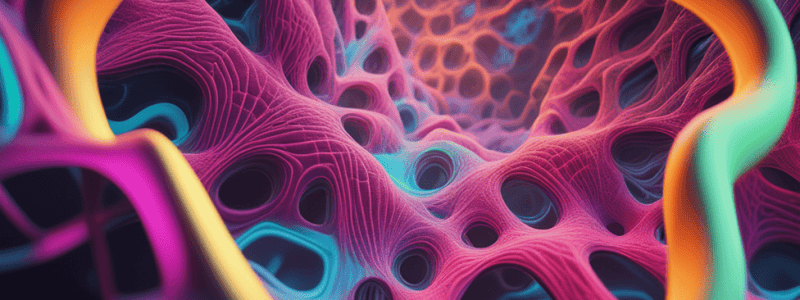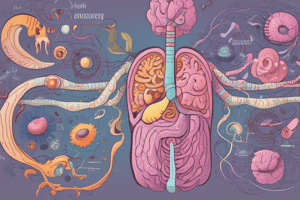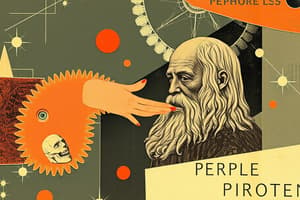Podcast
Questions and Answers
What is the primary route by which absorbed protein products exit the villous epithelial cell and enter the blood?
What is the primary route by which absorbed protein products exit the villous epithelial cell and enter the blood?
- Through the basolateral membrane
- As dipeptides, tripeptides, or tetrapeptides
- As individual amino acids (correct)
- Via luminal proteases
How are substantial amounts of protein absorbed from the intestinal lumen?
How are substantial amounts of protein absorbed from the intestinal lumen?
- Through the basolateral membrane
- As dipeptides, tripeptides, or tetrapeptides (correct)
- By luminal proteases
- As intact proteins
What is the general consensus about the number of distinct transport systems present at the apical membrane for amino acids?
What is the general consensus about the number of distinct transport systems present at the apical membrane for amino acids?
- Only one distinct transport system
- Three distinct transport systems
- Seven distinct transport systems (correct)
- At least five distinct transport systems
How do amino acids exit enterocytes into the blood during protein assimilation?
How do amino acids exit enterocytes into the blood during protein assimilation?
What mediates the exit of amino acids from enterocytes into the blood during protein assimilation?
What mediates the exit of amino acids from enterocytes into the blood during protein assimilation?
Which process involves hydrolyzing proteins to peptides and then to amino acids before absorption?
Which process involves hydrolyzing proteins to peptides and then to amino acids before absorption?
What is the primary function of luminal enzymes in protein digestion?
What is the primary function of luminal enzymes in protein digestion?
Which transporter is responsible for the exit of monosaccharides across the basolateral membrane?
Which transporter is responsible for the exit of monosaccharides across the basolateral membrane?
What is the primary mechanism of fructose absorption when SGLT1 cannot carry it?
What is the primary mechanism of fructose absorption when SGLT1 cannot carry it?
Which step is essential for proteins to be absorbed by enterocytes?
Which step is essential for proteins to be absorbed by enterocytes?
How are proteins absorbed when luminal enzymes digest proteins to peptides that are taken up as oligopeptides?
How are proteins absorbed when luminal enzymes digest proteins to peptides that are taken up as oligopeptides?
What type of proteins are essential amino acids derived from?
What type of proteins are essential amino acids derived from?
How are gastric and pancreatic proteases different from digestive enzymes for carbohydrates and lipids?
How are gastric and pancreatic proteases different from digestive enzymes for carbohydrates and lipids?
During what period does the absorption of whole protein by apical pinocytosis occur?
During what period does the absorption of whole protein by apical pinocytosis occur?
What is the uncertainty in adults regarding the absorption of intact proteins?
What is the uncertainty in adults regarding the absorption of intact proteins?
What is the fate of virtually all absorbed protein products as they exit the villous epithelial cell?
What is the fate of virtually all absorbed protein products as they exit the villous epithelial cell?
How does the movement of amino acids across the basolateral membrane occur?
How does the movement of amino acids across the basolateral membrane occur?
What type of transporters are responsible for amino acid exit from enterocytes into the blood during protein assimilation?
What type of transporters are responsible for amino acid exit from enterocytes into the blood during protein assimilation?
Name the 3 Accessory glands
Name the 3 Accessory glands
Order of digestion
Order of digestion
Which one is NOT a monosaaccharide
Which one is NOT a monosaaccharide
Which one is NOT a Polysaccharide
Which one is NOT a Polysaccharide
The small intestine can directly absorb monomers but not polymers
The small intestine can directly absorb monomers but not polymers
What happens to CHO during intraluminal hydrolysis?
What happens to CHO during intraluminal hydrolysis?
The products of starch hydrolysis are monosaccharides
The products of starch hydrolysis are monosaccharides
Disaccharides can be absorbed by the SI
Disaccharides can be absorbed by the SI
What happens in membrane digestion of CHO
What happens in membrane digestion of CHO
Glucose, Fructose, and Galactose are all absorbed the same way
Glucose, Fructose, and Galactose are all absorbed the same way
What transport process does Glucose and Galactose undergo?
What transport process does Glucose and Galactose undergo?
All 3 monosaccharides use the same facilitated sugar transporter (GLUT2) to exit the basolateral membrane
All 3 monosaccharides use the same facilitated sugar transporter (GLUT2) to exit the basolateral membrane
Protein has to be digested into what, before being taken up by the enterocytes
Protein has to be digested into what, before being taken up by the enterocytes
Describe the 4 digestion-absorption pathways of protein in the SI
Describe the 4 digestion-absorption pathways of protein in the SI
What is the key step before lipids can be digested?
What is the key step before lipids can be digested?
Only 15% of lipid digestion occurs in the stomach
Only 15% of lipid digestion occurs in the stomach
Why does most of lipid digestion happen in the SI?
Why does most of lipid digestion happen in the SI?
What enzyme completes lipid hydrolysis, and what is it aided by?
What enzyme completes lipid hydrolysis, and what is it aided by?
What happens when the fatty acids (generated from lipid hydrolysis in the stomach) reach the duodenum?
What happens when the fatty acids (generated from lipid hydrolysis in the stomach) reach the duodenum?
What is the role of CCK and how is it released?
What is the role of CCK and how is it released?
What form do lipids diffuse across the enterocytes as?
What form do lipids diffuse across the enterocytes as?
What are the 2 steps to CHO digestion?
What are the 2 steps to CHO digestion?
Flashcards are hidden until you start studying





